Abstract: The Perseids 2022 were recorded between August 6th and 19th with two almost identical receiving systems, which differ only in the antennas. It’s a cross yagi and an omnidirectional antenna, a discone. Surprisingly, the discone gives the better Perseid results. The Perseid stream contained many very large echoes or particles, often appearing in bursts. There was no strong outburst like in 2021, but a small burst was detected at the same point, at solar longitude 141.5. There were no pronounced notches like those of the Arietids or the Geminids. Between August 28th and September 12th the Northern Iota Aquariids (NIA) were recorded. The September Perseids showed little activity in this time window. Surprisingly, the NIA instead provided interesting insights: a notch is clearly visible, allowing some details to be viewed.
1 Introduction
Notches in meteor histograms are known in the literature. According to Felix Verbelen (Verbelen 2019), there are notches in all major streams. Kaufmann (Kaufmann 2020) postulates that head echoes produce a very large Doppler shift, so the signal is out of range of the receiver, which would result in a notch. In my first meteor paper (Sicking 2022) I proposed a mechanism for how notches appear in GRAVES meteor data. The Perseids 2022 should now provide further insights. Eventually, only a small notch was observed, but there were a few other unexpected surprises.
2 Setup
The meteor echoes are recorded with two almost identical systems. They differ only in the antennas, which are a right-hand circularly polarized 4-element cross-yagi and an omnidirectional antenna, a discone, with vertical polarization. The discone/cross yagi combination is actually used to test my hypothesis about the notches and the in-line-effect. The antennas are mounted in the attic, so that the configuration can be easily changed. Low-noise preamplifiers with a frequency range of 140-150 MHz and a noise figure of 0.25 dB are connected directly to the antennas. The receivers are Icom IC-R8600. Spectrum-Lab (SL) serves as the recording software. SL generates plots every 20 seconds with the appropriate date and time in the file name, which are evaluated later with a self-written image processing software based on Python3 and OpenCV. The histograms in Figure 1, 5 and 6 are smoothed with a variable Gaussian filter over up to 11 hours, while the histograms in Figures 2 and 3 are smoothed with a fixed Gaussian like filter with the coefficients 0.31, 0.74, 1.0, 0.74 and 0.31. The feature of plotting different sizes in different traces allows insights into the streams that are not necessarily visible in the sum. After many tests I estimate the uncertainty on the rate to be <5%. At the maximum of the streams, the error may be higher if the echoes are too close to each other. During the period examined, I saved Canadian Meteor Orbit Radar (CMOR) screenshots several times a day. This allows the peaks to be assigned to the currents. This is necessary because minor shower activity is not sustained by the method of single station meteor echo detection. The radiant heights were estimated using Stellarium Web for Dijon in France, located close to the GRAVES radar. Unless otherwise noted, data are shown from the right hand circularly polarized antenna.
3 Results and Discussion
The histograms of the two receiving systems are shown in Figures 1 and 2. The scale is identical in each case. In Figure 1, the white lines with the letters a) and b) show that the X-Yagi delivers more echoes than the omnidirectional antenna on the days before and after the Perseids. This is because the directional antenna faces south toward GRAVES and thus collects more forward-scattered signals than the omnidirectional antenna.
However, the Discone detects significantly more Perseid echoes than the directional antenna in relation to the baseline and also in absolute terms, as the comparison of the lines marked with a) and b) shows. In numbers: The Perseids grow out of the basic level by a factor of 1.99 for the Discone and by a factor of 1.58 for the X-Yagi. This is because the Perseid radiant is farther north, so the directional antenna for the Perseids is pointing in the wrong direction. The southern showers, the Aquariids and the daytime Xi-Orionids are better captured by the directional antenna. Details of the southern streams are discussed below.
The blue area in Figure 2 shows the histograms in bins of ten minutes of the rate and the green area shows the rate weighted by the sizes. The long green spikes indicate that the Perseid shower contained many very large echoes/particles, often appearing in clusters. Figure 3 shows a comparison of the Perseids with the Arietids: The rates don’t differ that much, but the meteors are significantly larger in the Perseids when comparing the rates weighted with the sizes.
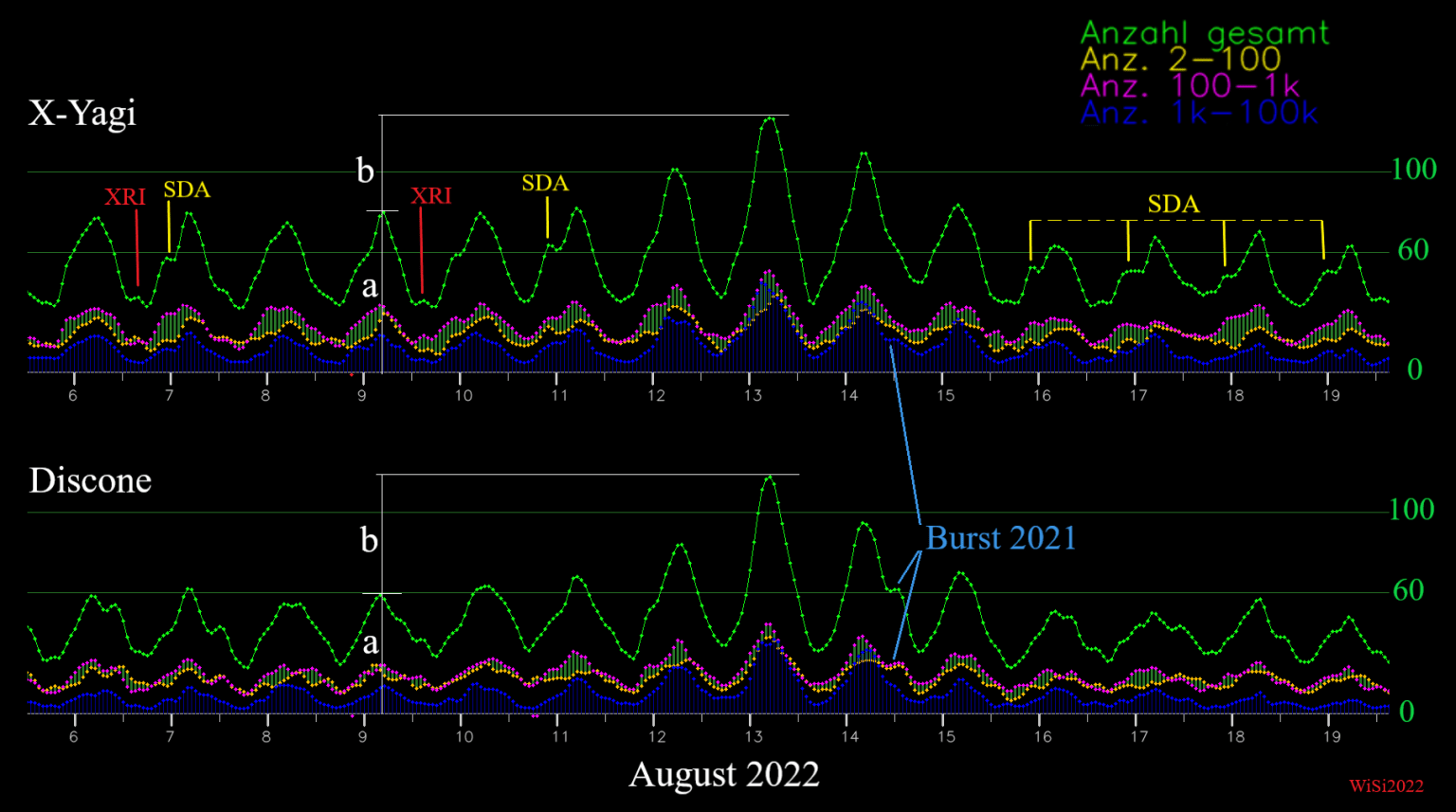
Figure 1 – Comparison of the X-Yagi and the Discone data of the Perseids 2022. The figure shows the meteor detection rate for different echo sizes. The blue lines represent the rate of large echoes (1k-100k pixels), the purple line shows the medium sized echos (100 to 1k) and the yellow line shows the small echoes (below 100 pixels). Finally, the green curve shows the rate of all sizes summed up.
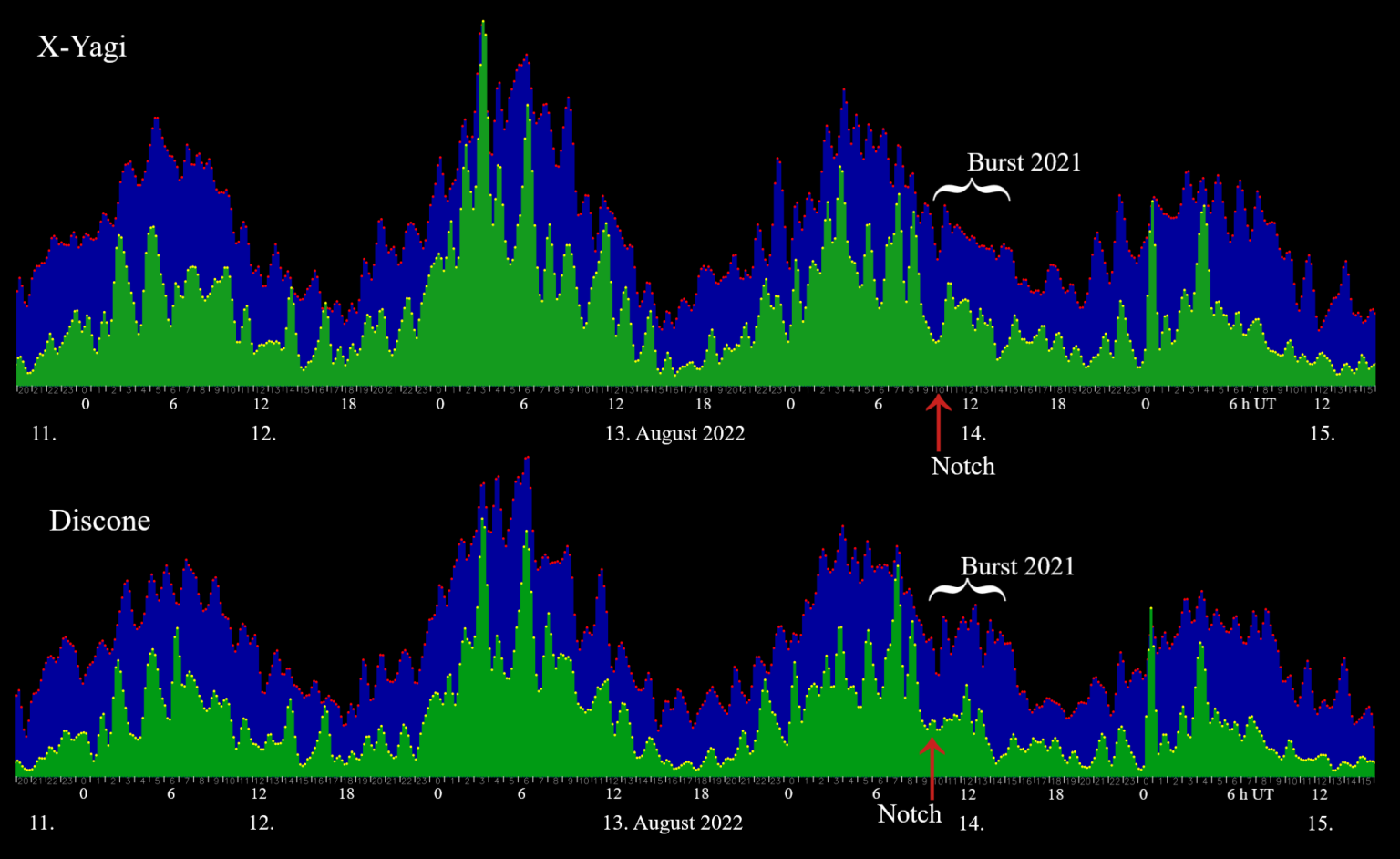
Figure 2 – Histograms of the rate (blue) and of the rate weighted by the sizes (green) in bins of ten minutes. Probably the plot shows a notch on August 14 at 10 h UT, see text. The small burst is clearly visible in the Discone data.
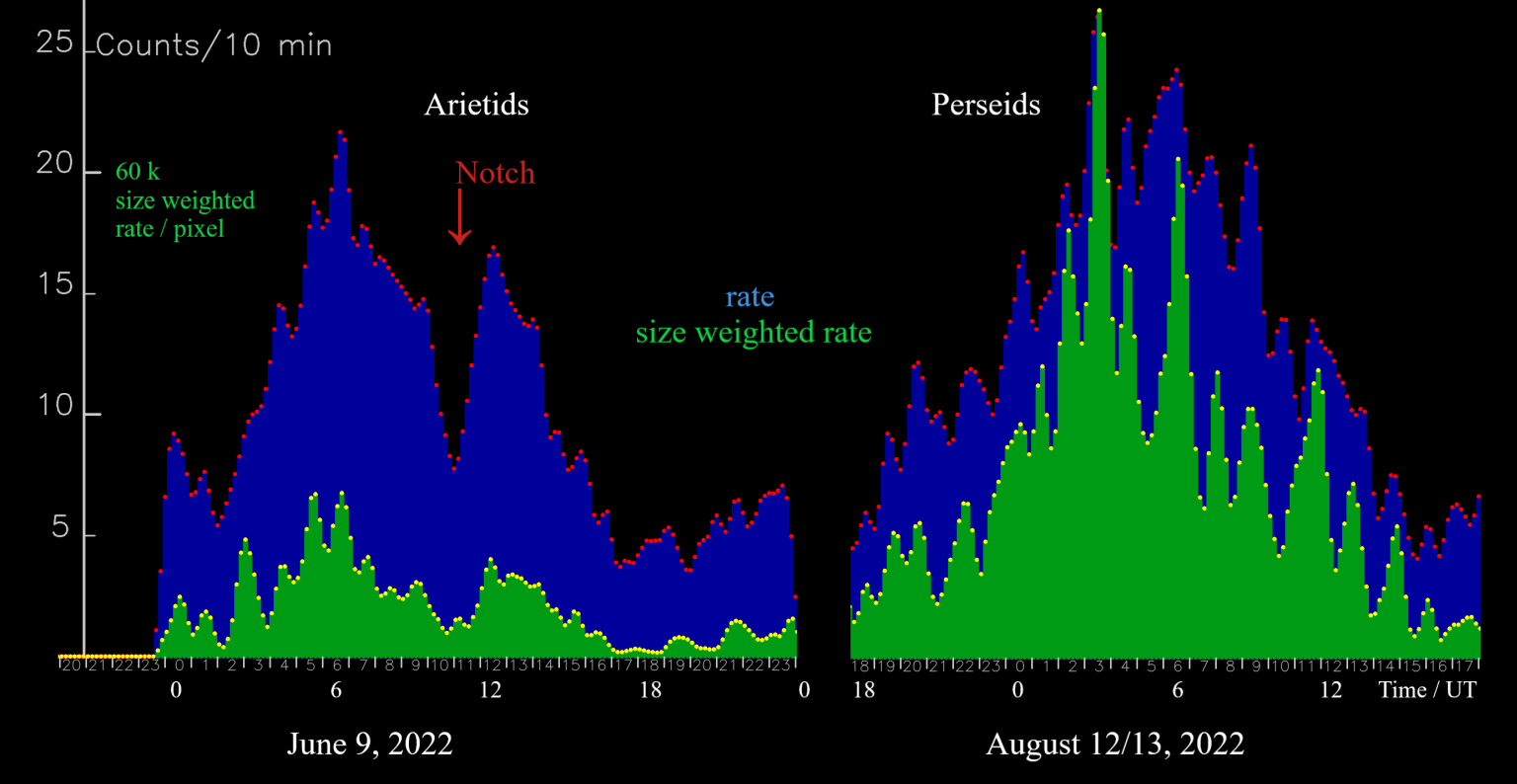
Figure 3 – Comparable histograms of the rate and of the rate weighted by the sizes of the Arietids and the Perseids. The rates don’t differ that much, but the meteors are significantly larger in the Perseids when comparing the size-weighted rates.
Perseid Outburst
The data show a mini-burst on August 14 between 10 h UT and 16 h UT, see Figures 1 and 2. At this point, solar longitude λʘ = 141.489° on August 14, 8:30h UT, according to Miskotte et al. (Miskotte 2021) a very large outburst was observed in 2021. So I labeled the point Burst 2021. This is probably the same burst, just smaller. At the maximum of the burst in 2021, the radiant height was 57°. On the other hand, in 2022 the solar longitude of 141.489 corresponds to 14:30 h and a radiant height of only ~18°. Judging by the plots, the mini-burst 2022 seems to consist of small material. Presumably, the (normal-sized) particles are poorly visible because of the deep radiant and are simply registered as small echoes. The burst, like the main Perseid stream, is more visible with the discone than with the directional antenna and therefore cannot be one of the southern streams. The peak is also visible in the data from RMOB observers, see for example entries by Ian Evans1, Philip Norton2, Philip Rourke3 and Felix Verbelen4 on August 14, 12h-13h UT.
To the notches
Figure 3 shows a comparison of the Perseids with the Arietids. The Perseids do not have a clear notch as in the Arietids, since the radiant does not pass southern of the GRAVES antenna. However, the signal dip on August 14 at 10 h UT could be a notch see Figure 2, the red arrows. At that time the radiant height was ~45°. The wider notch in the discone data and the small in-line peak at the lower red arrow suggest, that it is a real notch. Since the GRAVES transmitter radiates to the south, only a lower transmission power in side lobes and back lobes goes north. In the case of the Perseids, therefore, a large number of less intense echoes are detected. A weak signal along with a strong one, presumably a main lobe signal, is shown in Figure 4. Maybe next year I should record the Perseids with a third antenna pointing to north.
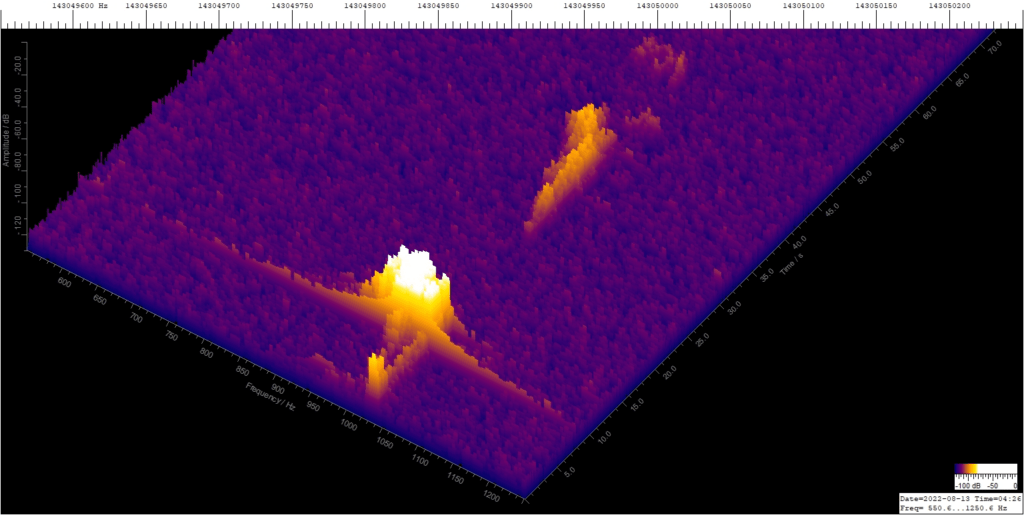
Figure 4 – Original Spectrum Lab output from 04:26 h UT on August-13-2022. Two echoes (above the threshold) are visible, a strong and a weak.
Daytime Xi Orionids and Aquariids
Not only sporadic meteors and the Perseids, but also some other streams were active during the observed days. The main showers that occurred during the period are:
- XRI, Daytime Xi Orionids,
- SDA, Southern Delta Aquariids,
- NDA, Northern Delta Aquariids,
- NIA, Northern Iota Aquariids,
- PER, Perseids,
- SPE, September Epsilon Perseids.
On August 7th and 9th, daytime Xi Orionids (XRI) are marked in Figure 1. It must be XRI peaks, since according to CMOR no other radiant was active at that time and location. The Southern Delta Aquariids (SDA) are also active throughout the period. Some peaks are marked too. The three Aquariid currents form a larger radiant field, so the peaks (and notches) are correspondingly wide. In Figure 1 they are labeled “SDA” because SDA is the dominant stream. The maximum radiant height is about 2h UT.
As with the Aquariids, the radiant field of XRI is very wide too. The radiant of XRI covered according to CMOR the entire constellation of Gemini and is not located at Orion. The maximum radiant height is at about 9-10 h. Figure 5 shows the August 6 and 7 in more detail. The maximum of the radiant is indicated by an arrow. Like at the Arietids a notch in the XRI trace is generated, so that finally a local maximum at about 16 h UT instead of 10 h is visible in the green trace. The same happens with the SDA: the sum, the green trace, shows a local maximum in the wrong place at 23 h UT instead of 2 h UT. The next chapter shows an example that is perhaps a bit clearer.
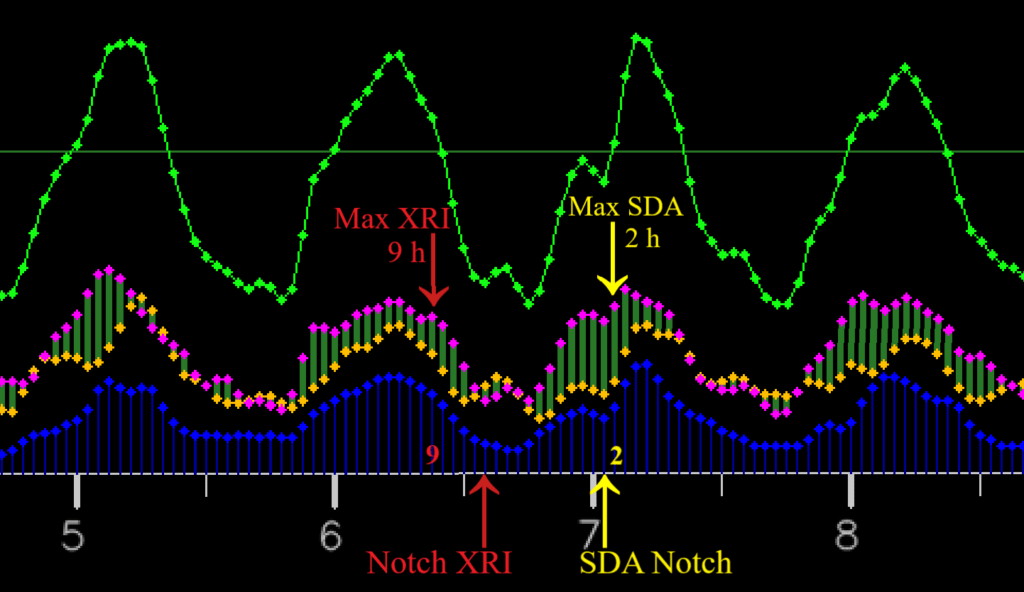
Figure 5 – The figure shows how the two peaks in the green trace on August 7 were formed by the superimposition of notches on the streams, see text. Admittedly, the effects are small, but the example shows that weak currents can be detected with simple means. The filter-width was chosen in a manner, that minima and maxima are shown a bit more clearly.
September Perseids and Northern Iota Aquariids
Between August 28th and September 12th data were collected to prove the September Perseids which should peak on September 9th. However the September Perseids are not visible as a maximum in the graphical representation, although the counts increase slightly, see Figure 6. According to a personal communication with Felix Verbelen, the Ieper (49.99 MHz) data clearly show increased activity from September 8th to 11th. Instead, the Northern Iota Aquariids (NIA) are clearly visible with very nice peaks one to two hours before midnight, although they had already reached their maximum on August 25th.
The red curves show the radiant height of the NIA. The maximum of the radiant height is 48°at 0h-1h UT. The sum, the green trace has local maxima around 21h-22h, which is about 2-3 hours too early for the NIA. This can only be caused by a notch that hide the echoes. This can be illustrated particularly well on September 4th: According to CMOR, only the NIA were active on September 4th. Therefore the radiant field was small and the maximum, the result of the NIA and notch, is very sharp. The situation was made clear by a small drawing, see the left inset in Figure 6. However I have to add caution: The NIA shower is not confirmed by video. The small particles are probably beyond the reach of most systems.
The middle inset shows that the yellow trace, i.e. the small echoes, are mainly responsible for the dip. The purple trail, the medium-sized echoes break in less and the big blue break in barely. It was different with the Geminids and Arietids – the reason is still unknown. The angle from which the notch grips can be roughly estimated with 20°.
Conclusions
The data show a mini-burst on August 14 of the Perseids. A comparison with the Arietids shows that the rates do not differ that much, but the meteors in the Perseids are significantly larger and appear in clusters.
Weak showers like the XRI and SDA are covered in the normal daily cycle of the meteors, however they give themselves away through the notches as the notches are very narrow and sharp while the maxima are wide and flat. This fact was used, for example, for the minimum bearing.
The knowledge about notches is important. The sporadic meteors are also affected, but the effect is not visible because no dip is visible. Overall, the effects leads to an underestimation of the sporadic meteors and of the showers. Finally, observing notches is a nice feature to look for weak showers.
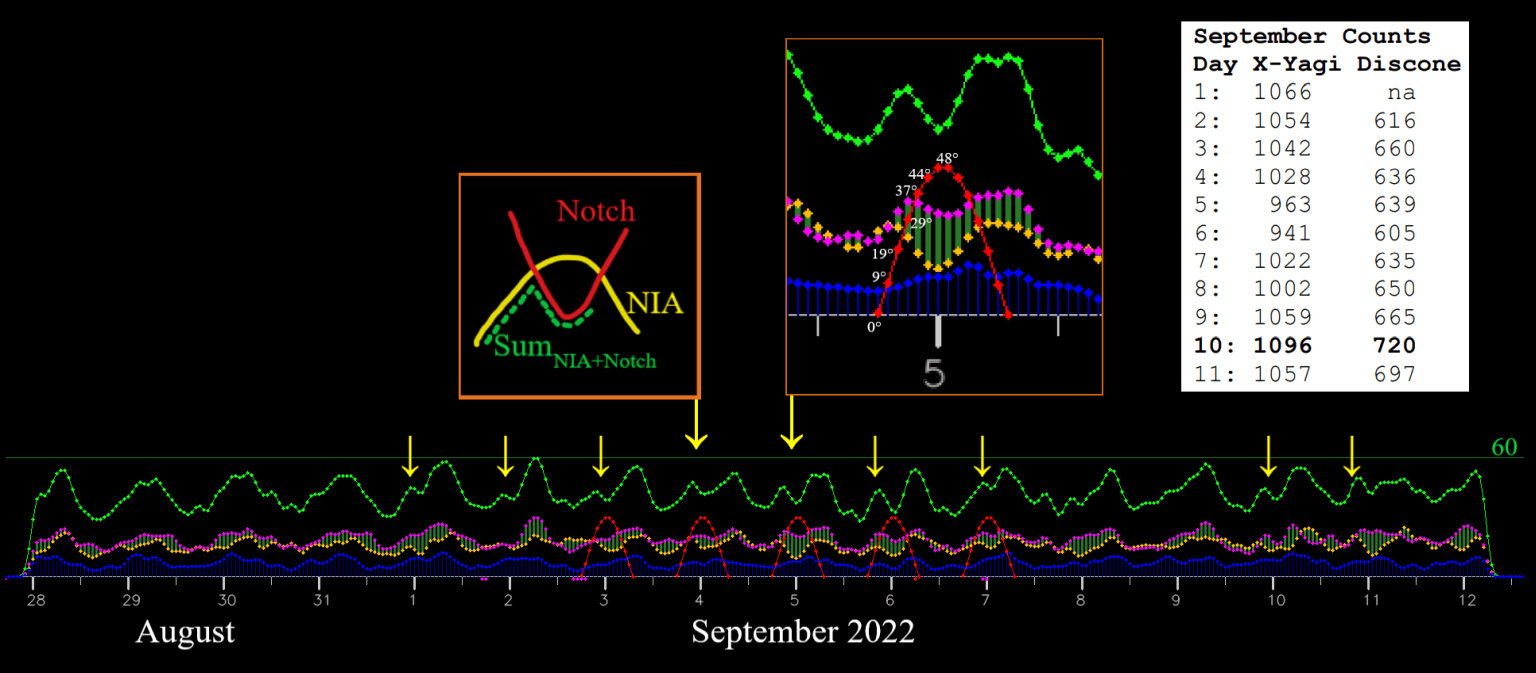
Figure 6 – Data between August 28th and September 12th. Instead of September Perseids, Northern Iota Aquariids (NIA) are clearly visible, see the yellow arrows. The left inset shows how the green trace results from NIA + notch. The middle inset shows how the different sized echoes decay at different rates. The right inset shows the counts accumulated over one day. A slight maximum is seen on September 10th, but is not visible on the hourly charts of both antennas. Discone hourly data are not shown.
Acknowledgment
Many thanks to Paul Roggemans, Felix Verbelen and Richard Kacerek for reading the article and for helpful comments according my interpretation of minor shower activity.
References
Verbelen F. (2019). “Meteor velocity derived from head echoes obtained by a single observer using forward scatter from a low powered beacon”. WGN, Journal of the International Meteor Organization, 47:2, 49–54
Kaufmann, W. (2020). “Limitations of the observability of radio meteor head echoes in a forward scatter setup“. WGN, Journal of the International Meteor Organization, 48:1, 12-16
Sicking, W. (2022). “A Notch in the Arietids Radio Data and a new so called In-Line-Effect”. EMetN, 7:5, 331-335.
Miskotte K., Sugimoto H., Martin P. (2021). “The big surprise: a late Perseid outburst on August 14, 2021!”. eMetN, 6:7, 517-525.

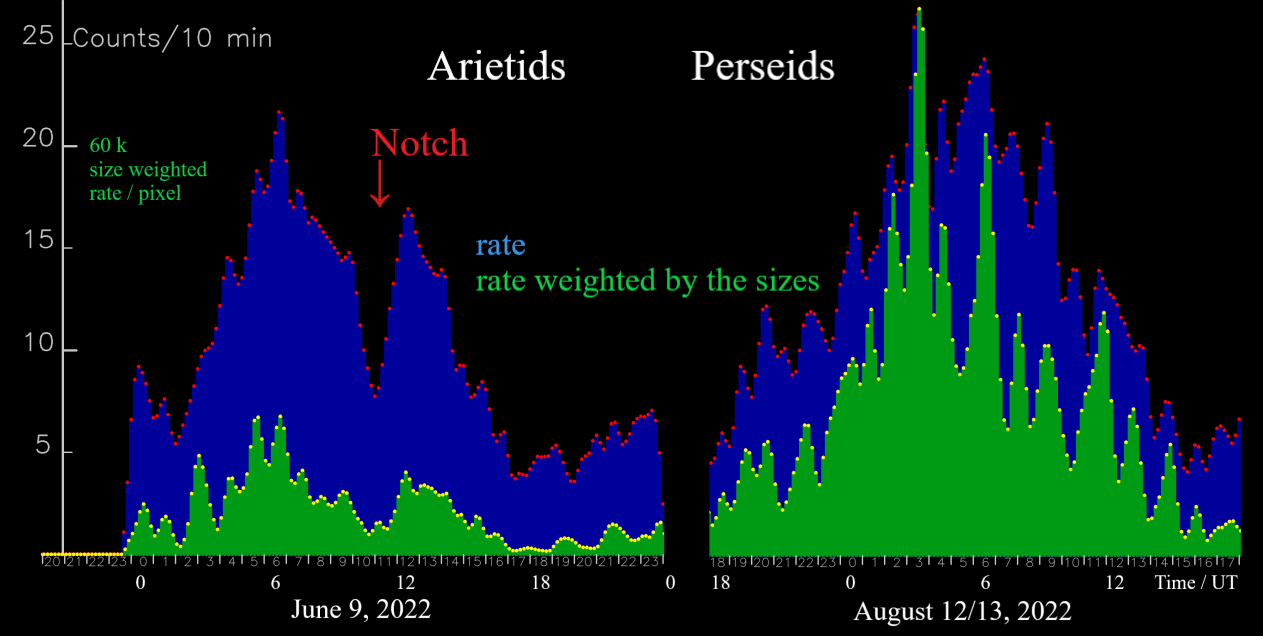




Hi Wilhelm – Excellent results and discussion!
I was surprised the discone did as well as the 4-element Yagi because I’ve always considered the discone to be a 0 gain antenna, which I confirmed through modeling.
I use Argo for recording HF meteor trail reflections from the WWV and WWVH time-frequency stations, both of which are around 4000 km from my Anchorage, Alaska observatory. I do not gather count data, only spectral data. A comprehensive report here: https://reeve.com/Documents/Articles%20Papers/Reeve_MeteorRadioObsrv.pdf
I use the same setup for aurora radio reflections, too.
Dear Whitham.
Thank you for your comment. I’ve been very happy about it.
I downloaded and skimmed your long article, but I will read it carefully.
Greetings from Germany to Alaska,
Wilhelm